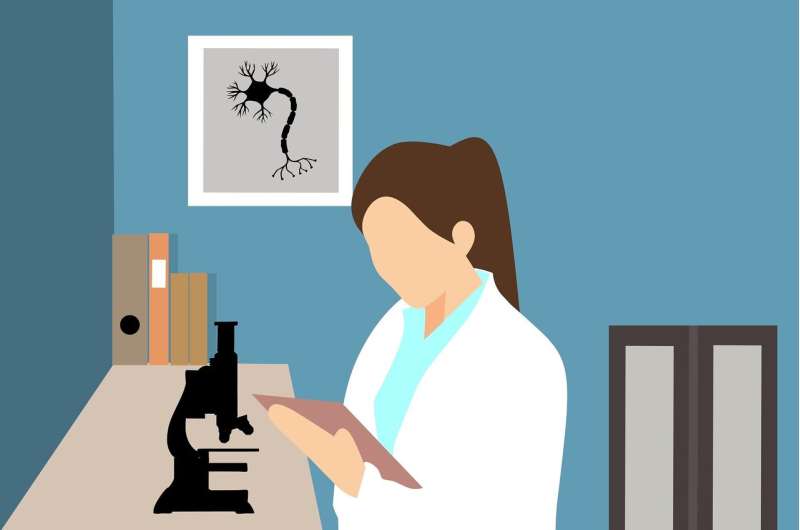This article has been reviewed according to Science X's editorial process and policies. Editors have highlighted the following attributes while ensuring the content's credibility:
fact-checked
peer-reviewed publication
trusted source
proofread
Gender disparities limit chances for women PhD students training to be new inventors, says new research

In the innovation economy, individuals with STEM Ph.D.s are a critical source of human capital, with nearly 60% of Ph.D.s in STEM fields—such as engineering, chemistry and biology—being employed outside of universities. These students are increasingly contributing to commercial science through patenting. New research from MIT Sloan School of Management and Copenhagen Business School has investigated the training of these Ph.D. students to better understand the pipeline and preparation of new inventors.
Conducted by Fiona Murray, MIT Sloan professor and associate dean for Innovation and Inclusion, and Mercedes Delgado, associate professor of Strategy and Innovation at Copenhagen Business School and research affiliate at MIT, the research focused on whether Ph.D. students start their careers as inventors early, filing their first patent during doctoral studies.
In their paper published in Proceedings of the National Academy of Sciences, titled "Faculty as Catalysts for Training New Inventors: Differential outcomes for Male and Female Ph.D. Students," Delgado and Murray found that Ph.D. students' advisors play a critical role in training new inventors. Faculty advisors who are themselves top inventors serve as catalysts for encouraging their advisees to become new inventors through co-patenting. Four percent of Ph.D. students at the top 25 universities ranked by patenting became new inventors, but when advised by a top inventor faculty member, the probability of them filing their first patent increased to 23%.
An important finding in the research was that female STEM doctoral students are less likely to become new inventors compared to their male counterparts during the years of their training.
"Is the opportunity to become an inventor during Ph.D. training equally available to female and male students? This is a phenomenon that hasn't been studied before and the short answer is 'no,'" said Delgado.
"We found that the female share of new inventors was nine percentage points lower than the female share of Ph.D. graduates in our university sample," Delgado continued. "This means that even early on in the career pipeline of Ph.D.s, there is an inventor gender gap higher than one would expect given the female share of STEM Ph.D. students."
To better understand this gap, the researchers focused on the role of faculty advisors, especially since advisors and Ph.D. students patenting together as co-inventors on work coming out of a lab is a key channel for advisees to learn how to patent and become new inventors. Faculty advisors who are themselves top inventors accounted for 44% of all new inventor Ph.D.s in the study's sample—highlighting their key role in training the next generation of inventors—and the gender gap in the likelihood of first-patenting was exacerbated when a student's advisor was not a top inventor.
"To put this starkly: female Ph.D.s have a 21% lower likelihood of being matched with advisors who are top inventors than male Ph.D.s, and even when matched, are approximately 17% less likely than their male Ph.D. counterparts to become new inventors," Murray said.
"This means there is a 'leaky pipeline' of female inventors-to-be even when these women make it into the labs of top inventor advisors at top universities. Not surprisingly, these findings have significant implications for inclusive innovation in STEM fields and more widely for the startups and large corporations who hire these talented students," she continued.
Although there is no single contributing factor, the researchers, in their paper, describe a number of factors that may contribute to this differential outcome, falling into "supply-side" factors and "demand-side" factors. Supply-side factors include differences between female and male advisees in patenting preferences, self-assessment of skills, or access to resources.
The researchers found no measurable differences in the thesis topic that male and female students are doing that might contribute to lower patentability. On the demand-side, "our findings are consistent that women's innovation skills and contributions are somewhat under-valued by advisors" Murray said, noting that, "even in the same lab with the same advisor and in similar fields, female Ph.D.s have a lower probability of patenting."
The research project has yet to test the effectiveness of different interventions. There are certain interventions that the research suggests could increase the number of female new inventors, for example, having a better understanding of the advisor-advisee matching process so that more women are trained by advisors who are top inventors, or encouraging female faculty themselves to engage in high levels of patenting, which would also increase the pool of female top inventor advisors for future doctoral students.
The early training in patenting and commercial science is particularly important because of the cumulative advantage these individuals could have over time with this experience.
"Imagine you became a new inventor during your Ph.D. studies," Delgado said. "We think that can have—and this is a question for our follow-on work—a long-lasting effect because after graduation you enter an organization and already know how to do commercial science, so you'll be an even more productive inventor during your career."
"By offering more opportunity and access to further training and experience with the patenting process and other entrepreneurial activities for all Ph.D. students, but especially for women, we will improve innovation throughout our economies at a time when this is especially important for national competitiveness," Murray said.
More information: Mercedes Delgado et al, Faculty as catalysts for training new inventors: Differential outcomes for male and female PhD students, Proceedings of the National Academy of Sciences (2023). DOI: 10.1073/pnas.2200684120
Journal information: Proceedings of the National Academy of Sciences
Provided by MIT Sloan School of Management



















